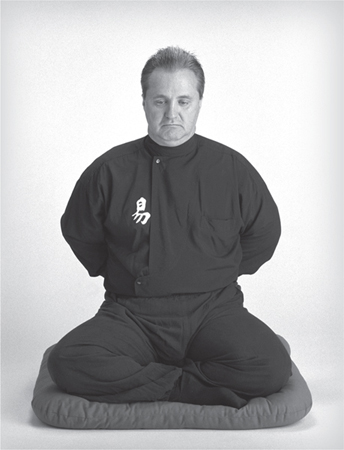
THE SIXTH BROCADE
THE DOUBLE PASS WINDLASS

This chapter, as in the preceding, begins with my translation of the instructions, commentary, and correct method that were included in the Kao Lin engraving. Following the original text are Li Ching-yun’s commentary and my comments, and finally my instructions for practicing the Sixth Brocade.
The Original Text
Wind the Double Pass Windlass.
Stretch out both feet loosely;
Loosely place both legs out.
The correct method: The shoulders are moved equally like a pendulum thirty-six times. Imagine the heat in the lower abdomen passing upward through the Double Pass and into the brain. Take in pure air through the nose. Afterward, stretch out the legs.
Author’s Comments
Note from the drawing that the hands are open. As with other aspects of Eight Brocades practice, this deportment has been eliminated in contemporary works, and this brocade is usually shown with two fists performing the movement.
The Double Pass has two interrelated meanings. The first relates to the two qi channels that intertwine upward and around on the left and right sides of the spinal column. In ancient Taoism, these were referred to as the Blue Dragon and White Tiger. The Hsing ming chih kuai (Instructions on the endowments of destiny), a sixth-century Taoist work on meditation and breathing techniques, contains an illustration that clearly explains these two channels.
The second reference is to the Double Pass cavity, which is located on the number one vertebra on the spine. If you were to lean back against a wall, curve your back, and move it up and down, the bone you would feel protruding in the center of your back would be the location of the Double Pass cavity.
The Blue Dragon and White Tiger channels intersect at the Double Pass cavity. It is difficult for the qi to pass through this cavity because the skin and bone here are so closely knit that the blood has difficulty passing through. If blood flow is difficult, the flow of qi will be difficult as well.
Li Ching-yun’s Commentary
After having performed each of the previous seated exercises, having endured them for a long period of time, the lower limbs can experience tiredness, and if they are not readjusted, they will certainly become exhausted. For this reason, they should be allowed to stretch out. The method is to simply uncross the folded legs and gradually stretch them out toward the front, straightening them completely.
These exercises should not cause excessive tiredness, but if the legs do become very weary after you have sat cross-legged for a long period of time, they must be stretched out. Otherwise, the result will be that the veins and arteries of the lower limbs could possibly suffer some sort of injury.
Author’s Comments
Li’s commentary immediately above would normally follow after his comments in the Fifth Brocade. However, because I have chosen to explain both the Single Pass Windlass and the Double Pass Windlass deportments—which is in keeping with the original text—I have placed his comments here, at the end of the Sixth Brocade.
 Author’s Instructions
Author’s Instructions
Both hands are held open with the back of the wrists placed on the waist. The eyes gaze straight ahead. Sway the shoulders like a pendulum, twisting the torso to move the left shoulder first, then the right, alternately thirty-six times, as though rowing a boat with first the left oar and then the right.
This brocade stimulates the liver.

Back of the wrists placed on the waist

Winding the Double Pass Windlass to the left

Winding the Double Pass Windlass to the right